Drakk Alfar
Appearance:
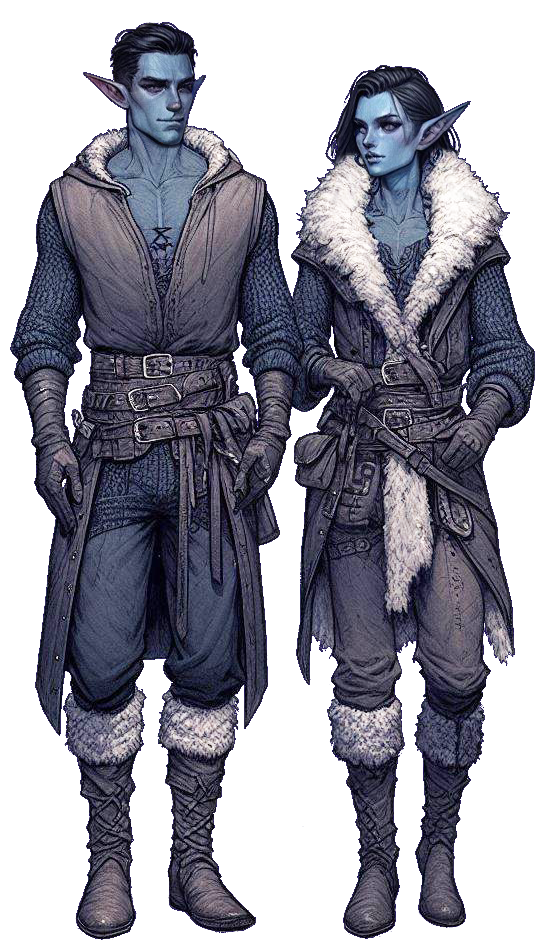
Build:
- From slim to muscular.
Height:
- Females: 155-165
- Males: 160-170
Weight:
- Females: 55-65
- Males: 55-70
Lifespan:
- Females; 4000
- Males: 4000
Skin:
- Black with blueish tint
Hair:
- Black, rarely white.
Eyes:
- Green-blueish.
Timeline:
Language:
- SINONSTRA
- REALMISH
- NIMZAXIAN
- WESTRIL
- ILEISH
- OL-DARIN
- HIGH-ARLINIAN
- VULARIAN
- OST-ARLIAN
- THA-ARLIAN
- SOUTH-DARIN
- RIM-DARIN
- EAST-DARIN
- WEST-DARIN
- UPPER-DARIN
- MAARKISH
- FINDONIAN
- EAST-FJELLAS
- WEST-FJELLAS
- EAST-DALISH
- WEST-DALISH
- LOW-NALDAN
- HIGH-NALDAN
- NORTH-UTAR
- SOUTH-UTAR
- NORTH-SKOGISH
- EAST-SKOGISH
- UPPER-SKOGISH
- SOUTH-SKOGISH
- WEST-SKOGISH
- CENTRAL-SKOGISH
Culture:
Army List:
Heroes:
Vampires:
- Mehelge Huintyy'r
- Ranty Rentulak
- Garamar ne Gideti
- Pinteqa lo Faxtux
- Gillionalia Miola
- Igren Ellýs Sinej
Liches:
Legend
“Older than their spirit kindred, the Ljost Alfar, Drakk Alfar sagas tell of the birth of time, and the ‘Wilderness Stallion’.”
Description
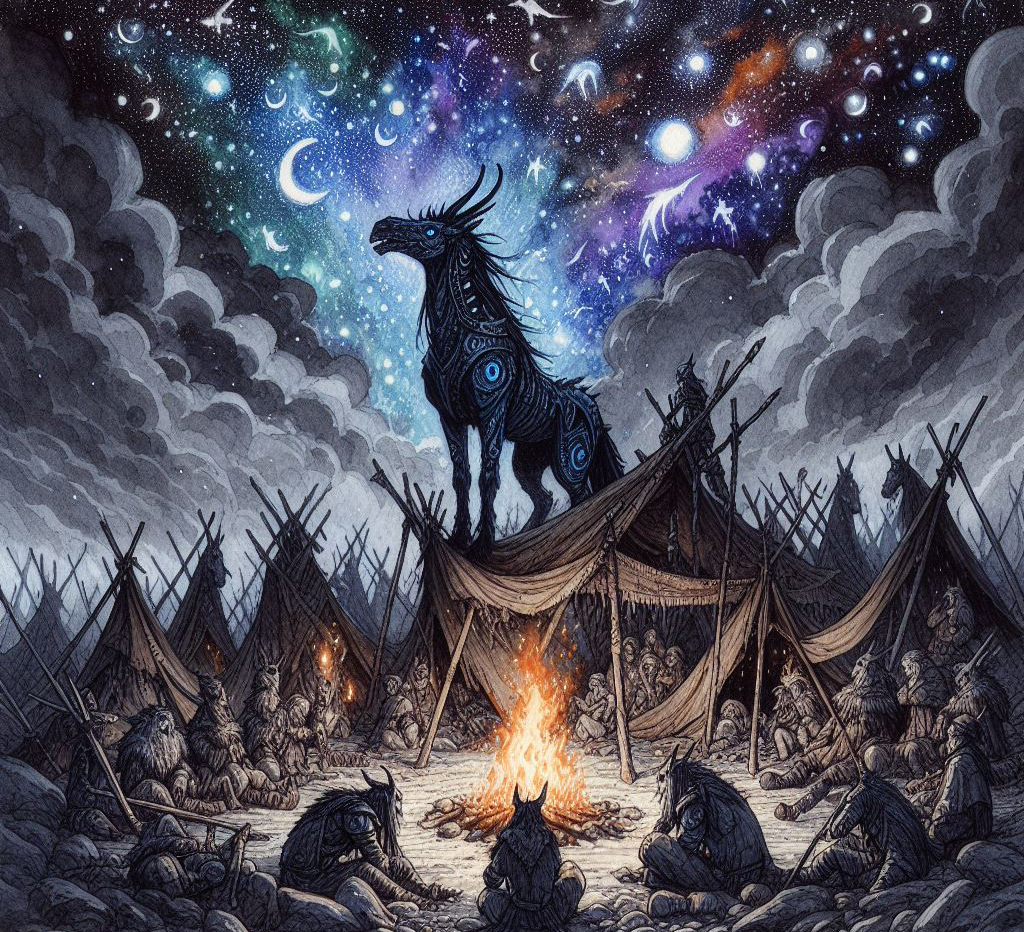
In ancient times, before the world as we know it took form, the Drakk Alfar were born under a vast, open sky filled with mana leaks that glittered like gems on a velvet cloth. As these primordial beings emerged they wandered the boundless void, a landscape untouched by mortal hands, where the air was thick with the raw magic of creation, and their essence became intertwined with the very fabric of things
Central to their early beliefs was the Wilderness Stallion, a mighty and ethereal creature believed to embody the untamed energies of the astral. The Wilderness Stallion was not just a physical being but a manifestation of freedom, strength, and the raw, unyielding power of things. The Drakk Alfar revered the Stallion, crafting statues and totems in its likeness, often depicting it with flowing mane and wild, fierce eyes that seemed to hold the secrets of the mana leaks.
The stallion’s statues were carved from the rarest of stones, imbued with magic, and placed in sacred groves and high places above their dwellings under the open sky. These statues served as focal points for their rituals and songs, which were said to call upon the stallion’s spirit for guidance and strength.
As they live underground they came to lack the gleaming skin and freshness of a smile, but are still considered handsome by other races and are regarded as fabulous smiths.
Skjald Sigurd
History
Dark AgesDespite their initial existence in the open void, a profound change came upon the Drakk Alfar. Legends speak of a great disaster where the skies darkened and a void garden was wracked by violent storms. Some tales suggest that the stallion itself then guided them to seek refuge in the embrace of the earth, sensing the need for a new sanctuary as the void gardens grew increasingly hostile.
The Drakk Alfar ventured into the depths of the void gardens, finding solace in the dark, stable caverns that contrasted sharply with the tumultuous surface. Here, in the bones of the gardens, they discovered a different kind of beauty and magic. The underground sang to them, its songs deep and resonant, and they found that their skills in smithing, runes, and magic were even more potent in these subterranean realms.
Even underground, the Drakk Alfar’s veneration of the Wilderness Stallion did not wane. They adapted their practices to their new environment, carving intricate statues and reliefs of the stallion into the walls of their caverns. These underground sanctuaries became places of profound reverence, where they would gather to sing their magic songs and perform rituals that echoed through the stone halls.
The stallion, now seen as a guardian of both the wild surface and the hidden depths, became a symbol of their resilience and adaptability. The Drakk Alfar’s lore grew to include tales of the Stallion galloping through the veins of the void, its spirit ensuring the stability and vitality of their underground realms.
Living underground shaped every aspect of Drakk Alfar society. Their appearance, slightly more pallid compared to their Ljost Alfar kin, became a mark of their unique heritage. Their clothing, made from soft and rigid leather, protected them from the rough, unforgiving environment. Their legendary craftsmanship in metal and rune magic flourished, making their artefacts highly sought after by other races.
Their knowledge of herbs and plants, although different from that of surface dwellers, was no less extensive. They cultivated rare fungi and subterranean plants, mastering the lore of the underground flora. Their magic allowed them to move unnoticed among humans when they chose to visit the surface, blending in seamlessly due to their deep understanding of enchantments and illusions.
Skjald Valgrif
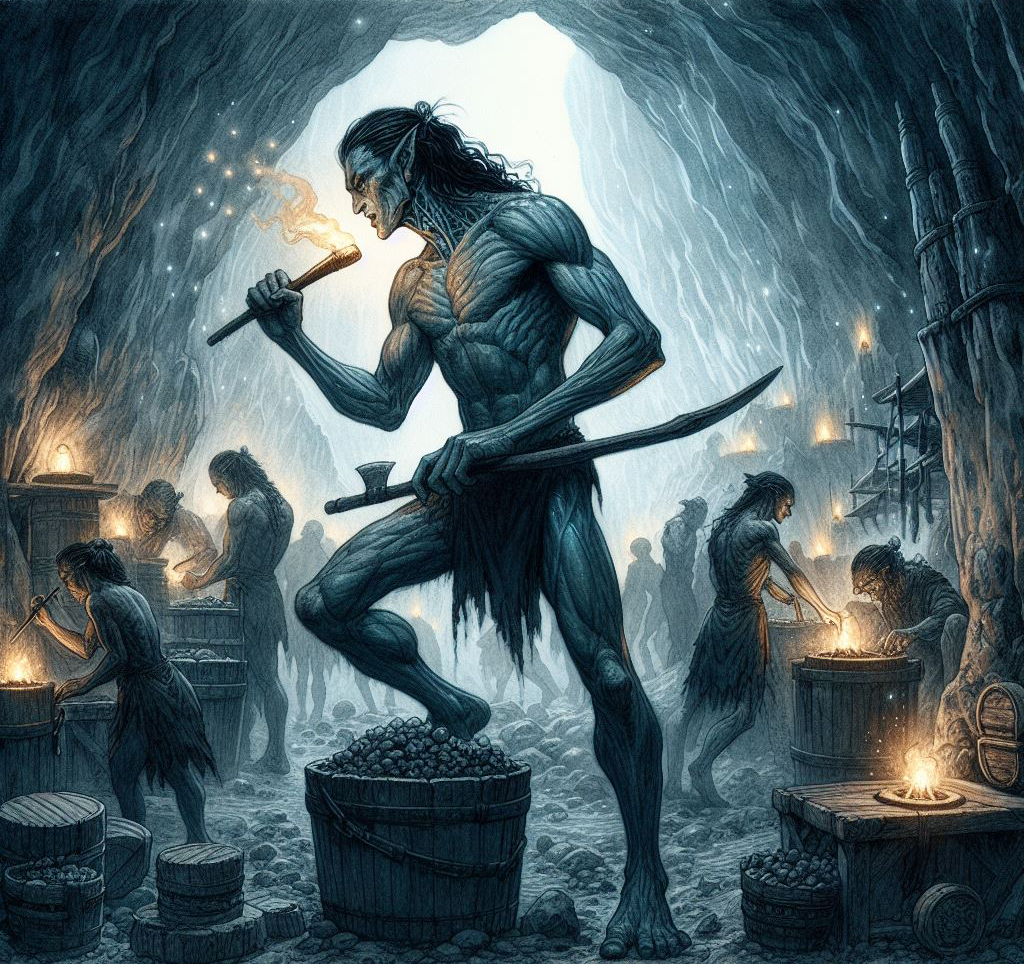
After the divine races altered the astral, void, and void gardens to shape the world, the surface transformed into a place of great beauty and wonder. The once chaotic and hostile environment became more habitable with lush forests, tranquil waters, and vibrant skies. However, despite these changes, the Drakk Alfar chose to remain in their underground homes. This decision was influenced by a combination of cultural evolution, spiritual beliefs, and practical considerations.
Over the centuries spent underground, the Drakk Alfar developed a profound bond with the earth. They had come to see the subterranean as their true home, a place where they could fully harness their unique abilities. The deep tunnels and caverns resonated with their magic, enhancing their smithing, rune crafting, and herbal lore. The echoes of their songs and spells felt more powerful in the stone halls, creating an environment where their culture and skills could flourish unimpeded.
The Drakk Alfar’s veneration of the Wilderness Stallion also played a crucial role. They believed that the stallion’s spirit permeated the earth, guiding and protecting them. The sacred statues and carvings within their caverns were more than just symbols; they were focal points of spiritual energy. The stallion was seen as a guardian of the hidden depths, a protector who ensured their safety and prosperity in the underground realms. Moving to the surface would mean leaving behind these sacred sites and the concentrated spiritual power they held.
The transition to living underground had not only ensured their survival during times of chaos but also allowed the Drakk Alfar to develop a unique identity and culture. Their pale, blueish, handsome features, distinct clothing, and unparalleled craftsmanship became hallmarks of their race. Their underground realms, with their challenges and mysteries, shaped their character, making them resilient and resourceful. The Drakk Alfar viewed their subterranean existence as a testament to their adaptability and strength, a legacy they were proud to continue.
Living underground also provided strategic advantages. The Drakk Alfar’s hidden cities and fortresses were naturally fortified, offering protection from potential surface threats. Their secretive nature and the ability to move unnoticed among most other races added to their mystique and deterrence against invaders. The vast network of tunnels allowed for efficient travel and communication across their realms now that astravel had malfunctioned, further cementing their preference for underground living.
The Drakk Alfar were also custodians of ancient knowledge and artefacts. Their underground libraries, workshops, and vaults held secrets and treasures from ages past. Moving to the surface risked exposure and the potential loss of this invaluable heritage. The isolation of the underground allowed them to preserve and protect their lore, ensuring that their wisdom and artefacts remained intact for future generations.
Skjald Vinotis
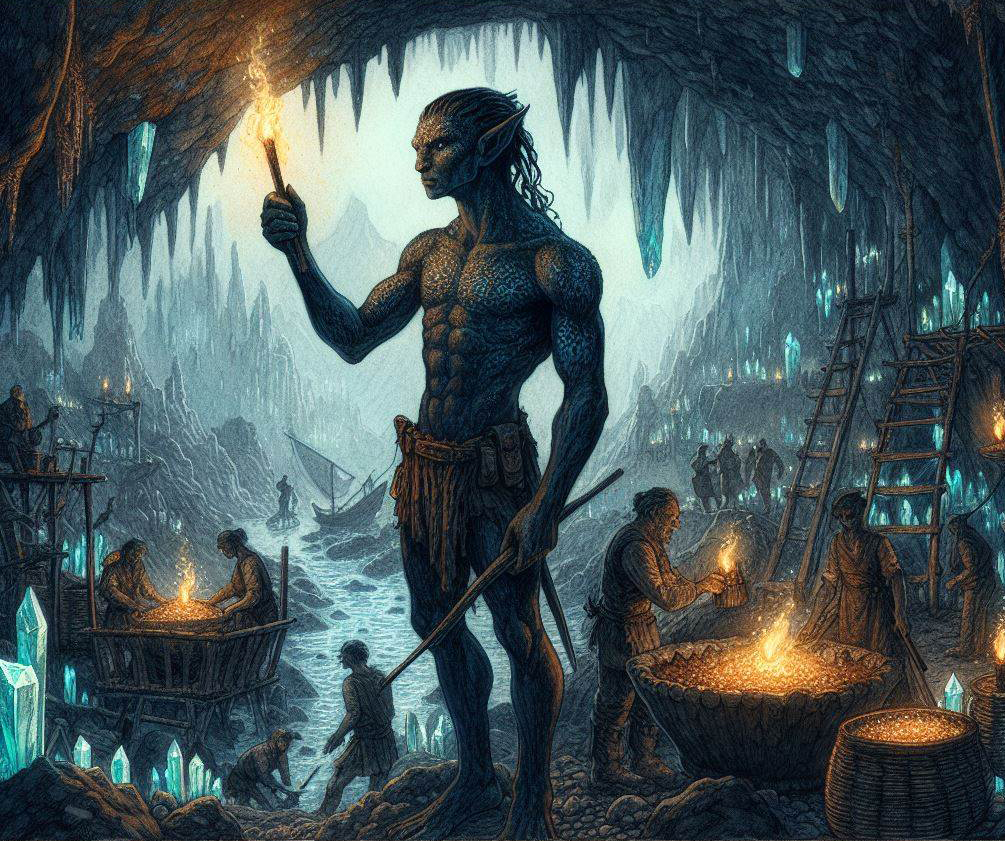
During the 1st Cataclysm, many came to realise what the disasterous void garden event had been. Some of their elders and ancestors had been transformed into Vampires, and that was why their kin suddenly became feared, hunted, and killed. Realising the innocence of vampires, Drakk Alfar stood by their former kins side.
The decision of the Drakk Alfar to remain underground, even after the divine transformation of the world, was deeply rooted in their cultural identity, spiritual beliefs, and practical considerations. Their profound connection to the earth, reverence for the Wilderness Stallion, and the strategic and preservational benefits of their subterranean existence all contributed to their choice. The underground realms were more than just a refuge; they were an integral part of who they were, shaping their destiny and defining their legacy in the tapestry of the world’s history.
As the second age unfolded, Drakk Alfar and vampires did grow apart. So when the Bullheaded God emerged, it passed by every Drakk Alfar realm, but its followers, the Wanderers, became a whole other issue.
Skjald Ulrich
Third Age
As the wanderers came, interest in the astravel sites renewed, and the millennia-old Academy of Ri in the Bay of Skelop was rebuilt at the edge of what is known as the strongest earthnode in The Realm. No other place did magic flow stronger, faster, or more turbulently. So it was only natural to the scholars that an astral site or gate was at the very centre.
Yet in all its history, none had ever been able to activate this astral site or gate, nor had any known being ever emerged from it, despite some very rare claims of seeing it faintly shimmering. Thus, travel to the academy was mostly by ship, or via Astravel to neighbouring locations, and then on horseback or by walking. So, part of the academy’s studies was naturally devoted to the site Nick named ‘Maelstrom of the Gods’.
Skjald El Mary
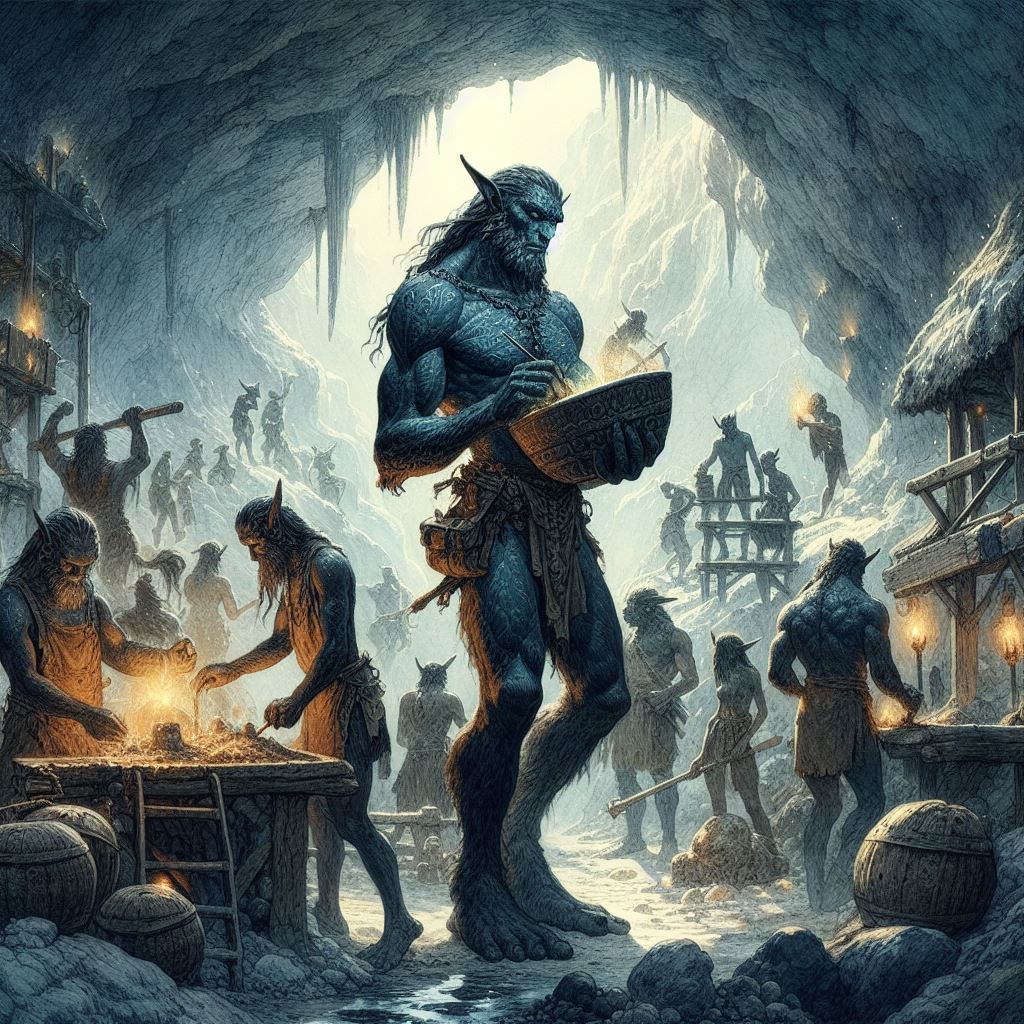
When the Vornir sang, Ljostari sank, and Mt. Vula erupted, the world tilted, Lava Imp's emerged, and a magically tainted tsunami polluted our world, giving birth to the Arisen, and the Rim closed.
After this, the magic energies flowed differently, and the skills of Drakk Alfar crafters became even more legendary. Especially Uar Knosso Perimax, who, back in time, had learned from Mawmen who taught their magic glass crafting skills to some Drakk Alfar. They also learned the secrets of Ljosti Bronze.
It is said that one of the divine teardrops that fell outside Lake Mirror was carved into a fabolous gem and placed in an Izno-Gold for the emperor of the N'Aldaan by two Dwarves and Uar Knosso Perimax.
Skjald Sejrik
Let me tell you two things, the oddest one first. I was told after the Great Invasion that the day students noticed that the ‘Maelstrom of the Gods’ did shimmer faintly was the same day the Kinoblin junk with me onboard sailed by just south of the island. So I suspect those stunted creeps were involved in all previous connections or activation attempts, but I can’t confirm that now that the academy is ruined.
Anyway, the other thing is about the Great Invasion… naa, wait. We can do it another day. I need to grab that wine over there.
Skjald Yell'a'Beard
Environment
Skjald Sejrik
Cartography

Some settlements worth noting are the following:
At Findon, in Skelops Southern part. Out in the Niralla Strait lies the Axni Island where a huge amount of Drakk Alfar live. There are both what is considered normal Drakk Alfar, but the Em Ru Arran Mana Manipulators also resides there. Alongside the Drakk Alfars live two Indigenous. Archaic, some Clovincaz, and one Moss'Ari Tribes. With whom they even married, and thus there are also a few settlements of Half-Human living there. But generally, the Isle is ruled by the Drakk Alfar, and the various Common folks living at the shores and harbour towns are the link to the outside World. Thus, the potent Drakk Alfar Ingredients are traded here, and outsiders are rarely welcomed further inland than these ‘Gates to the Drakks’.
At Dalip, in Amrad, there are two known Drakk Alfar lokations: one at Mt. Aggnurs, who at times aided in Amrad’s defence against raids from Bowei, and a more isolated lot further west in Nurr Mountains.
Also at Dalip, in Agion, the Drakk Alfar from Mt. Wyrrol at the border to Bowei joined forces with Archaic, Ogryl and some Common. Beating a rather aggressive coalition of Jomzaar, Indigenous and other Common Tribes, in Mopraars Marshlands.
At East Fjella, in Tusla, there are at least three Drakk Alfar settlements: Bizli Top, Peak Hrafni, Mt. Smapve. and we suspect there’s also one at Mt. Depol. Normally, they are very secretive and don’t deal with outsiders, yet it is rumoured that a Thursar is seen wandering about—at times even in the company of someone from Dawn Reborn or a ommoner. So, as they somehow become more social when travelling the lands seeking information about the Thursars hereabouts, One can easily find one selv sharing a campfire with a Drakk Alfar in that situation.
At Markeoy in Bragurgs, where Bay of Braburg narrows, and it turns into Rabuns Fjord lies Mt. Strim. In that mountain resides a large amount of Drakk Alfar as well, often dealing with the T'Aurs at Mumuarki.
Skjald Ulrich
Organisation

They dislike wood and water and prefer to live in carved constructions throughout the entire world, except at the Rim, especially below ground in huge caves and cities, recovering all that is possible of nature’s resources, which they turn into artefacts of great value. Finding their domains is normally difficult and is best attempted at sunset.
Skjald El Mary
Military
Skjald Vinotis
Special
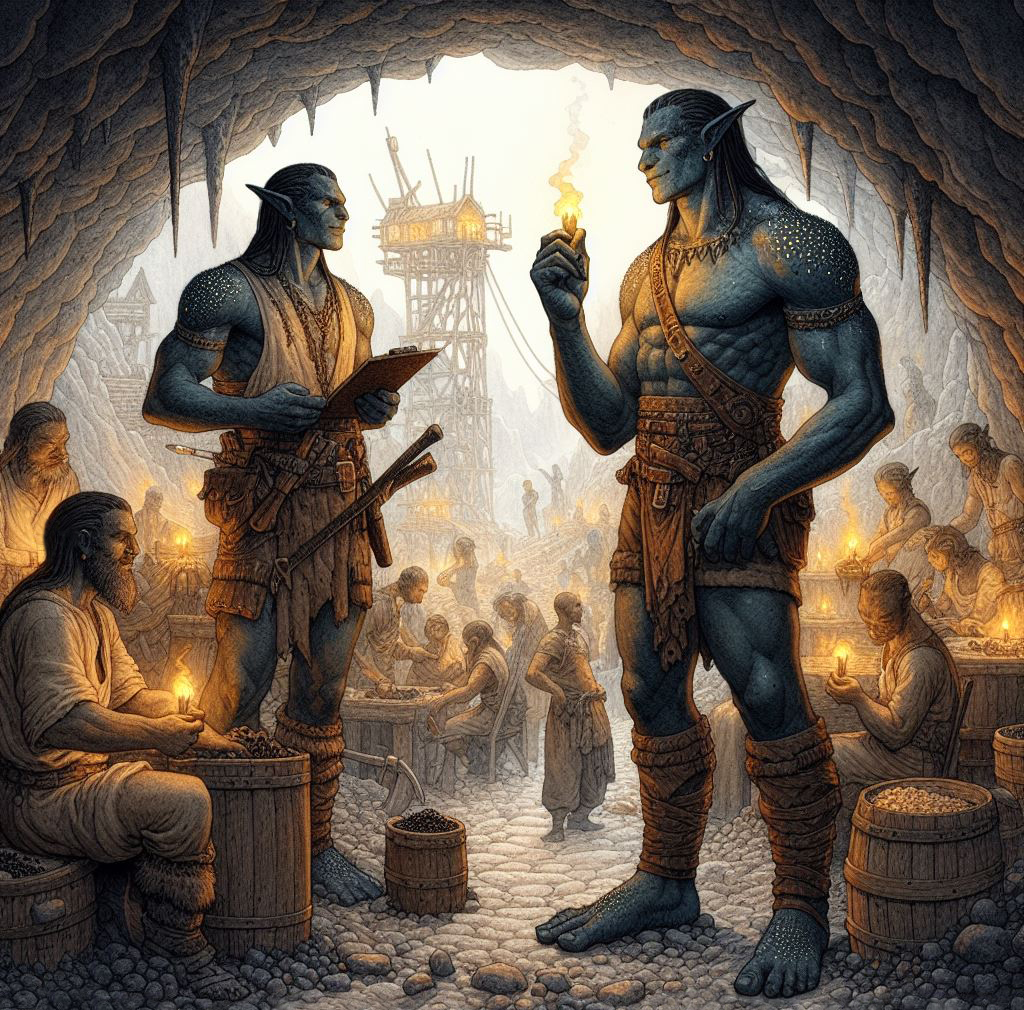
Most often, they take on those who find them as apprentices due to their demonstrated persistence and cleverness. They know all the languages of the Realm even though each individual generally only knows a dozen or so.
Skjald Valgrif
Story
| Suddenly it lit up, brighter than ever this millennia… shielding their eyes, pondering the humming as if hoofbeats… the portal suddenly flashed, and a shimmering wall to another place opened… and beyond the shimmering mist, a thousand eyes could be seen… teeth glittering, lips mumbling, hands wriggling, energies building up… Mana being released to such an extent that reality ripped…
Dozens of students died the very instant it opened up… scores fell lifeless and withered as energies were sucked from them… countless died shrieking as they were blasted or ripped apart… or melted, boiled, and warped by the very elements surrounding them… and then they began to organise… stand firm, counter spells, release might, and force themselves… and their elders arrived… It’s said hundreds of the Drakk Alfar died that day… but alas, the Sproblin was the right tool for the task… their vast amount gave them an upper hand… and slowly the Mages began to retreat towards the academy… as more foes poured from the great rift, tipping the tide further… So as the mages from the rest of the realm started to arrive, by horse, flight, sprint, and whatever… it was only to add to the fray at the very doorstep of the academy. All night they fought, in coloured shines dazzling every mortal… and slowly even the sturdiest, most skilled… despite attempts to boost powers beyond any precaution or rule, they ran dry and died… leaving only the very few extremely skilled grandmasters with the option to die or flee… resulted in the academy eventually being razed… meanwhile frenzied Sproblin slaughtered every being they encountered in the bay. Skjald Kazumix |
Last Updated on 2024-10-31 by IoM-Christian
